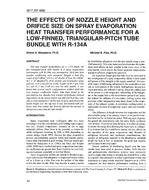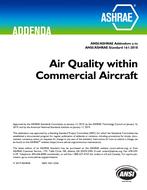Click here to purchase
A three-dimensional mathematical model developedearlier by Choudhary et al. (2010) was used to investigate heattransfer in two metal building wall insulation assemblies. Themodel predictions for the overall heat transfer coefficients (theU-factors) were tested with measurements from calibrated hotboxes for these assemblies. One °F the hot boxes consisted °Fa single layer °F R-25 (R-4.40 K.m2/W) fiberglass insulationinstalled over girts 48" (1.2192 m) apart. The other consisted°F R-13 (R-2.29 K.m2/W) fiberglass and R-30 (R-5.28 K.m2/W)fiberglass insulation layers installed over girts 60" (1.524 m)apart. The measurements were conducted with the insulationside facing the metering chamber and the wall side facing theclimate chamber °F the hot box. The metering chamber averageair temperature was 102.2 °F (312.15 K) for the single insulationlayer assembly and 100.04 °F (310.95 K) for the twoinsulation layer case. The climate chamber average airtemperatures for the two assemblies were 48.4 °F (282.26 K)and 49.97 °F (283.13 K) respectively.The predicted and measured heat transfer coefficients (Ufactors)were in 93.3% agreement for the single insulationlayer wall assembly and 95.5% agreement for the two insulationlayer assembly. The effect °F air motion in the flutes °F themetal wall panel °F the R-13 (R-2.29 K.m2/W) /R-30 (R-5.28K.m2/W) assembly on the overall heat flow was found negligible.The excellent agreements for the MBI wall assembliesobserved in the present study, in conjunction with the 93%-97% agreement reported previously by Choudhary et al. 2010)for the MBI ro°F assemblies, provide further confidence in theuse °F the mathematical model to study heat transfer in andcalculate U-factors for the MBI assemblies that contain fiberglassas the key insulation component.
Product Details
- Published:
- 2012
- Number of Pages:
- 9
- File Size:
- 1 file , 2.4 MB
- Product Code(s):
- D-SA-12-006
- Note:
- This product is unavailable in Russia, Belarus


